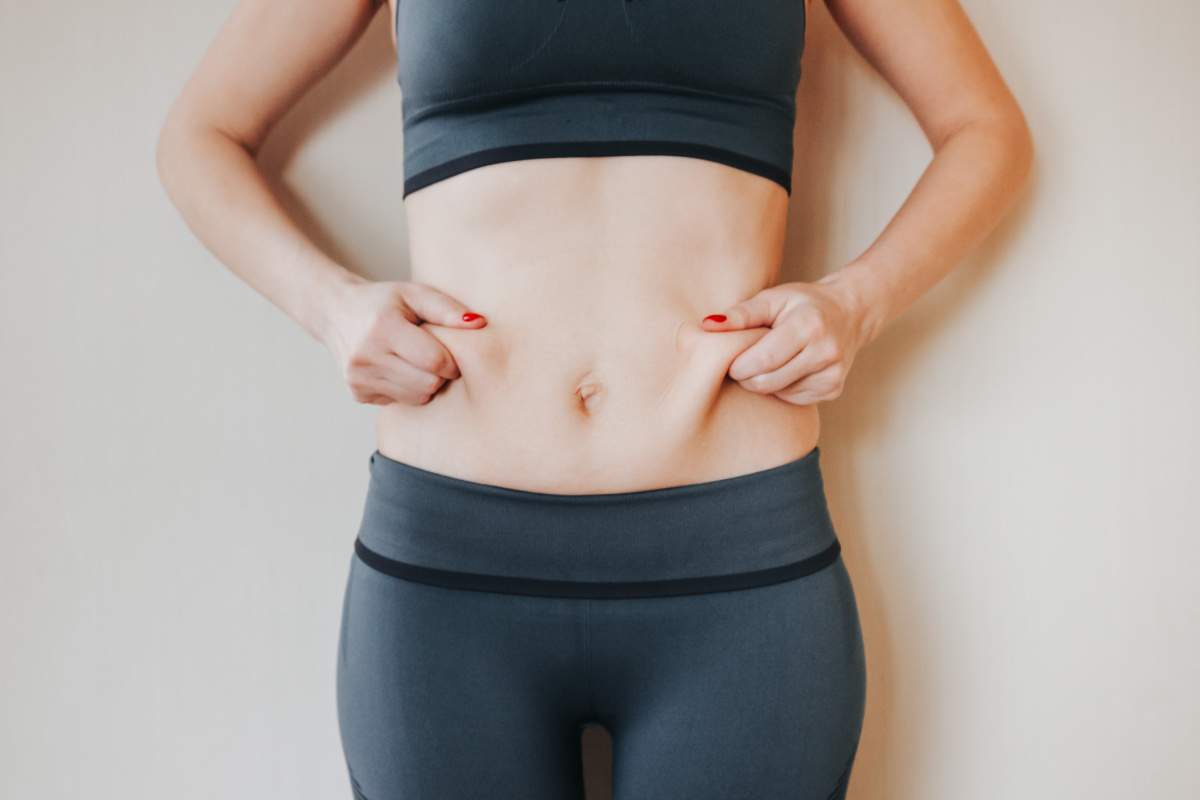The belly and lower back are the hardest areas to lose fat from, followed by hips and thighs for women and love handles for men. These stubborn zones store fat differently and respond slower to diet and exercise than other body parts.
Your body decides where fat comes off based on genetics, hormones, and how long the fat has been stored there. Belly fat especially includes both surface fat under the skin and deeper visceral fat around your organs, making it twice as challenging to shift.
Belly Fat Burns Last
Abdominal fat sits in two layers. The deeper visceral fat releases slower because it’s designed as your body’s emergency fuel reserve. This area also has more alpha receptors that actually slow down fat release compared to beta receptors that speed it up.
What works best
Resistance training three to four times weekly combined with walking burns belly fat more effectively than cardio alone. Australian research shows strength work increases your metabolic rate for up to 48 hours after training, targeting stubborn areas over time.
Daily action Walk 8,000 steps minimum and add two full body strength sessions each week using weights heavy enough that the last two reps feel challenging.
Lower Back and Love Handles
This area stores fat as protection around your spine and organs. For men especially, lower back fat tends to be the final zone that reduces during weight loss.
Spot reduction doesn’t work, but building muscle in your back, core, and shoulders creates better overall fat burning. Your body composition shifts when you gain lean muscle, pulling from stubborn reserves as it needs energy.
Weekly target Include bent over rows, deadlifts, and plank variations twice weekly to build muscle that forces fat mobilization from these zones.
9 Steps To Shed 5-10kg In 6 Weeks
Includes an exercise plan, nutrition plan, and 20+ tips and tricks.
Download FreeHip and Thigh Fat for Women
Hormones like estrogen direct more fat storage to hips and thighs. This fat serves biological functions and releases more slowly than upper body fat stores.
Creating a consistent calorie deficit through nutrition while maintaining muscle mass gives the best results. Crash diets actually make this worse by slowing your metabolism and causing muscle loss.
Nutrition approach Eat adequate protein (1.6 to 2.2 grams per kilogram of body weight daily) and reduce processed foods rather than cutting calories too low.
Hormonal Factors
Cortisol from chronic stress promotes belly fat storage specifically. Even with perfect training and eating, high stress hormones block fat loss from stubborn areas.
Sleep under seven hours nightly increases cortisol and reduces fat burning hormones by up to 55%. Quality rest matters as much as your training program.
Recovery protocol Aim for seven to nine hours sleep and include at least one full rest day weekly. Consider adding a 10 minute daily walk outdoors to lower cortisol naturally.
Why Some Areas Won’t Budge
Blood flow to stubborn fat areas is lower, meaning fat burning hormones reach these zones less effectively. The fat cells themselves are also more insulin resistant, holding onto stored energy longer.
Your body follows a genetic pattern for where fat comes off first and last. Most people lose from their face, chest, and arms before seeing changes in their problem zones. This is normal physiology, not a sign your program isn’t working.
Patience matters Fat loss from stubborn areas can take 3 to 6 months longer than other zones. Consistent effort wins over perfect short term intensity.
Frequently Asked Questions
What body part loses fat first
Your face, neck, and upper chest typically lose fat first, followed by arms and upper back. The exact order depends on your genetics and gender, but extremities and upper body almost always respond before your midsection or lower body.
How long does belly fat take to lose
Healthy fat loss happens at 0.5 to 1 kilogram weekly. Belly fat specifically might take 8 to 16 weeks to show visible reduction if you’re consistent with strength training and nutrition. The deeper visceral belly fat reduces before the surface layer becomes noticeably smaller.
Can you target fat loss in specific areas
No, spot reduction is a myth. Your body pulls fat from all areas based on genetics, not which exercises you do. However, building muscle in specific zones improves how that area looks and slightly increases fat burning nearby over time.
Why won’t my lower belly fat go away
Lower belly fat contains more stubborn alpha receptors that resist fat breakdown. This area also stores both subcutaneous fat under the skin plus deeper visceral fat. It requires getting to a lower overall body fat percentage, usually under 15% for men and 22% for women, before showing major changes.
Does cardio or weights burn belly fat better
Weights burn belly fat more effectively because muscle mass increases your resting metabolism permanently. Cardio burns calories during the session but doesn’t change your metabolism long term. A combination of both three to five times weekly gives optimal results.
What foods make belly fat worse
Processed foods high in added sugar and refined carbohydrates increase insulin, which promotes belly fat storage. Alcohol, sugary drinks, and excess omega 6 oils from fried foods also contribute. In Australia, cutting back on packaged snacks and takeaway makes the biggest difference for most people.
How much protein do I need to lose stubborn fat
Aim for 1.6 to 2.2 grams per kilogram of body weight daily. This protects muscle mass during fat loss and increases satiety. A 70 kilogram person needs roughly 112 to 154 grams daily, spread across three to four meals.
Will stress prevent me from losing belly fat
Yes, chronic stress raises cortisol which directly promotes abdominal fat storage and blocks fat burning in this area. Managing stress through sleep, outdoor time, and adequate recovery is as important as your training program.
At what age does it get harder to lose fat
Metabolism naturally slows about 2 to 3% per decade after age 30, mainly from muscle loss rather than aging itself. Building and maintaining muscle through resistance training prevents this decline regardless of age.
How do I know if I’m losing visceral fat
Waist measurements dropping faster than weight on the scale indicates visceral fat loss. Also, improvements in blood pressure, blood sugar control, and energy levels suggest reduced visceral fat even before visible changes.
Next step Start tracking your waist measurement weekly and add two strength training sessions focusing on compound movements like squats, rows, and presses. Give it 8 weeks before judging results in your stubborn areas.
Add to follow-up


